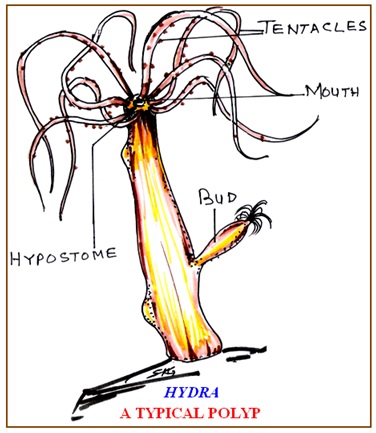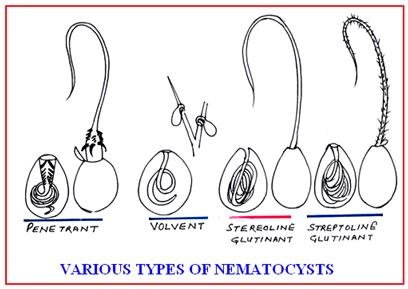Bio- Etymology PART – 4: PHYLUM – CNIDARIA
LEARNING BIO- ETYMOLOGY
‘Making Biology students interested in Etymologies’ !!!
- FUN TO LEARN BIOLOGICAL TERMINOLOGY
- THE LANGUAGE OF BIOLOGISTS
- SOWING SEEDS OF SYSTEMATICS / TAXONOMY
AT THE GRASSROOT LEVEL
- The Episode:
The episode of ‘Bio-etymology’ is devoted to analyzing the hidden meanings derived from the Names of various Animal Phyla and Classes, along with the terms specifically used to describe their respective diagnostics, important examples (Genus or species) etc.
- Recollecting the Introduction of PART – 1:
At any level, may it be animals in general or Man in particular, there is some structured or indicative or behavioural system of communication. It is simply referred to as a kind of ‘Language’. In a broader sense, ‘Language’ is the method of communication that involves the use of various languages (in various countries) spoken by man. Articulation of words in a definite sequence is the basic of formulating a Language and knowledge of words forming it and their ‘sense’ is of utmost importance. Accumulation of a treasure of words constitutes what is called ‘Vocabulary’ defined variously as follows:
- The words of a language.
- The body of words used in a particular language.
- All the words that exist in a particular language or subject.
- A list or collection of the words or phrases of a language, technical field etc.
- A listing either selective or exhaustive, containing the words and phrases of a language, with meaning or translations into another language.
Over a period of time in past centuries, Science is general and Biology in particular has accumulated a vast array of words to communicate fact(s) or phenomena through deriving their meaning.
Recollecting the ‘Bio-etymology’ Part – 2:
Phylum / Kingdom Protozoa – related ‘Etymology’ in Part – 2 refers to Protists of Whittakar’s 5 – Kingdom System and a Kingdom under 7 – Kingdom System by Cavalier-Smith, respectively.
Recollecting the ‘Bio-etymology’ Part – 3
As per Whittakar’s 5 – Kingdom System and Cavalier-Smith’s 7 – Kingdom System, all multicellular animals are included under Kingdom Animalia and out of 7 major Phyla, Phylum – Porifera-related Etymology is elaborated in ‘Bio-etymology Part – 3’. As the ‘History’ of Porifera reveals that ‘Parazoa’ was a separate group suggested for them and recognized as one of the 3 ‘Branches’ of Kingdom – Animalia viz.,
- Mesozoa: [Latin mesos = intermediate + zoon = animals]; a group of minute (< 8.0 mm) endoparasitic ciliated animals of marine invertebrates (in the kidney of Cephalopod Molluscs), without tissue and body cavity; intermediate between Protozoans (Bio-etymology PART – 2) and Metazoans [Gk. meta = after + zoon = animals]; the multicellular animals appearing after unicellular / acellular Protozoans viz., from Porifera to Chordata e.g., Phylum – Mesozoa (= unranked Phylum Dicyemida / Rhombozoa); exemplified by Diceyma. Dicyemida: [Gk. di = two + kyema = embryo + eidos = form of body] i.e., producing 2 types of embryos (larvae). Rhombozoa: [Gk. rhombos / rhombus = spinning top, magic wheel, a spinning motion, to spin, whirl or that which revolves] i.e., animals which exhibit whirling motion owing to ciliated nature.
- Parazoa: [Gk. para = beside, beyond, aside, amiss + zoon = animal]; i.e., ‘beside the animals’, meaning thereby ‘the multicellular animals to be kept aside owing to having less specialized cells than the Metazoans’, as exemplified by Phylum – Porifera (Bio-etymology PART – 3)
- Eumetazoa: [Gk. eu = true, well, good, easy, right + meta = after, next to + zoon = animals]; i.e., ‘well-defined / true animals’, appearing after Poriferans, characterized by the presence of cells differentiated into tissues and organs and an embryo that passes through a two-layered ‘gastrula’ stage. Of the above, ‘Parazoans’ are discussed with reference to Phylum – Porifera under Part – 3 of Bio-etymology.
‘Bio-etymology’ Part – 4
After Porifera, all Metazoans are included under Eumetazoa [Gk. eu = true + meta = after + zoon = animal] i.e., true animals, with ‘tissue’ or ‘organ’ grade of body organization. Based chiefly on the number of germ layers (Ectoderm, Endoderm and Mesoderm) in the embryo and the symmetry of body, Eumetazoans are segregated into two groups (two Divisions):
[A] Division: Radiata:
Body radially or biradially symmetrical and diploblastic (2 germ layers; Ectoderm and Endoderm) with tissue grade of body organization; as represented by the major Phylum – Cnidaria (= Coelenterata) as elaborated here under ‘Bio-etymology PART – 4’.
[B] Bilateria: [Gk. bi = two + lateros = sides] i.e., body divisible into two identical halves (right and left) only in one plane passing through the median longitudinal axis or simply ‘Bilaterally symmetrical’ animals, to be continued in ‘Bio- Etymology PART – 5’ and beyond.
PART – 4
Division: Radiata
PHYLUM – CNIDARIA (= COELENTERATA)
More complex than Poriferans (sponges), the animals commonly known as Hydras, Jellyfishes, Sea Anemones, Sea Pens, Sea Fans, Corals etc. are among about 11, 000 living species included under Phylum- Cnidaria (=Coelenterata); characterized by ‘cell-tissue grade of body organization’.
- History:
In the 4th Century BC *(=BCE), the ancient Greek Philosopher Aristotle (384 BCE – 322 BCE), aptly known as the ‘Father of Biology’, regarded these animals intermediate between animals and plants and due to their ‘stinging nature’, called them ‘Cnide’. French naturalist Jean-Andre Peyssonnel (1723) [1694 -1759] and Genevan naturalist Abram Trembley (1744) [1710 – 1784] proved them to be animals. Therefore, Swedish Botanist / Zoologist Carl Linnaeus (1758) [1707 – 1778], French naturalist Georges Cuvier (1796) [1769 – 1832] and French naturalist Jean-Baptiste de Lamarck (1801) [1744 – 1829] included them under ‘Zoophyta’, together with sponges. It was German Zoologist Karl George Friedrich Rudolf Leuckart (1847) [1822 – 1898] who created a group ‘Coelenterata’ to include both ‘sponges’ and ‘cnidarians’. Ultimately, Austrian Zoologist Berthold Hatschek (1888) [1854 – 1841] splitted ‘Coelenterata’ into three Phyla viz., Spongiaria (= Porifera), Cnidaria and Ctenophora.
*BCE = Before the common Era or Before the current Era (CE). BCE and CE are the alternative terms for Dionysian (after Dionysus, one of the earliest Gods mentioned in Greek culture) BC (before Christ) and AD (anno Domini or ‘in the year of the Lord’); e.g., 2020 CE corresponds to AD 2020 and 400 BCE corresponds to 400 BC. |
- Cnidaria Coelenterata:
From historical point of view, the term ‘Coelenterata’ has / had been widely used as the name of the ‘Phylum’ but in due course of time opinions emerged in favour of ‘Cnidaria’, on the basis of the following facts:
The term Coelenterata [Gk. koilos = hollow + enteron = gut or intestine + Latin ata = ‘a group’ or ‘a group of organisms characterized by a structure’]; identifies a group of animals characterized by the presence of a ‘hollow’ cavity inside, acting as a ‘gut’ or the ‘gut’ is what which is a ‘hollow’ cavity inside. Irrespective of the levels of body organization, this interpretation overlaps with other animals like sponges (also having an internal hollow cavity called spongocoel) or Ctenophorans and therefore, does not represent an ‘exclusive character’, diagnostic to Coelenterata.
In order to avoid ambiguity, the term ‘Cnidaria’ found favour to replace ‘Coelenterata’, owing to the first contention expressed by Arostotle, calling them ‘Cnide’, due to their ‘stinging nature’; hence, Cnidaria [Gk. knide = nettle = a herbaceous wild plant, Urtica sp., with heart-shaped leaves covered with stinging hairs, causing itching and pain].
All examples included under Cnidaria possess the so-called ‘most complicated cells in the Animal Kingdom’, the ‘stinging cells’, called Cnidoblasts [Gk. knide ….. + blastos = germ, embryonic cell] /Cnidocytes [Gk. knide….. + kytos = cell or fully differentiated mature cell], nowhere found in the Animal Kingdom, thus becoming the exclusive diagnostics of ‘Cnidaria’. Therefore, priority was given to Cnidaria (term frequently used by lady US Zoologist Libbie Henrietta Hyman 1940 [1888 – 1969]) over Coelenterata (coined by Leuckart), though both the terms are still used interchangeably / synonymously.
Pronunciation !! On some occasions it is observed that some people wrongly pronounce ‘Coelenterata’ as ‘ko-len-te-rata’ instead of its correct pronunciation ‘si-len-te-rata’. Similarly, ‘Cnidaria’ is seen to be pronounced as ‘s-ni-daria’ instead of ‘ni-da-ria’ [‘C’ being silent]; ‘Cnide’ should also be correctly pronounced as ‘nide’ [not si-nide]. |
- Definition / diagnostics:
Aquatic (mostly marine; some freshwater); solitary or colonial; sedentary or free swimming; diploblastic; radially or biradially symmetrical; hollow (having an internal gastrovascular cavity or coelenteron); asexually or sexually reproducing animals with a body organization of cell-tissue grade level, offensive and defensive stinging cells (cnidoblasts /cnidocytes), chitinous or calcareous exoskeleton and represented by one, two or more working individual units (zooids) different in form and function.
Structure and Life Cycle Related Terminology
Cnidology: [Gk. knide = nettle + logos = study, discourse of study, knowledge], the study of Cnidarians (= Coelenterata).
Solitary: [Latin solitaries / solus = alone] i.e., living singly.
Colonial: [Latin colonia / colony = inhabitants of a colony] i.e., living in groups.
Colony: [Latin colonia = settled land, farm, landed estate; or colonus = husbandman, tenant farmer, settler in new land; or colere = to cultivate, to till, to inhabit or dwell] i.e., a country or district colonized.
Sedentary: [Latin sedentarius / sedere = sit] i.e., animals which are sessile or fixed / attached at one place.
Sessile: [Latin sessilis / sessus / sedere = adhering close to surface; sitting or sitting on or to sit] i.e., attached to the substratum.
Diploblastic: [Gk. diplos = double + blastos = germ] i.e., with two well-defined germ layers viz., outer ectodermal epidermis and inner endodermal gastrodermis, with a jelly-like acellular mesogloea in between.
Epidermis: [Gk. epi = upon + derma = skin] i.e., outermost later of the skin (body wall).
Gastrodermis: [Gk. gaster = stomach + derma = skin] i.e., the skin (lining) of the stomach (gastrovascular cavity).
Mesogloea: [Gk. meso = middle + gloia, glia = glue, jelly-like] i.e., thin, delicate, transparent, non-cellular, gelatinous layer in between epidermis and gastrodermis; and secreted by both.
Physiological division of labour: Different types of epidermal and gastrodermal cells destined to work differently for the whole body.
Symmetry: [Middle French symmetrie or Latin symmetria or Greek symmetria = agreement in dimensions, due proportion and arrangement]
Or
[Greek syn = together with, along with, in the company of + metron = measure or me- = to measure] i.e., harmonic arrangement of parts.
Radially Symmetrical: [Latin radialis / radius = shaft, rod, spoke of a wheel, beam of light + symmetrical…….] i.e., an animal having a repeated pattern around central axis such that they can be separated into identical pieces when cut through the central point (section passing through any radius of a circular / cylindrical body).
Various Orders of Radii:
The position of tentacles and other parts of the body of Cnidarians is described with reference to their location on particular radii of Polyp or Medusa viz., 4 perradii (identified on the basis of the position of most structures along it, like angles of mouth, radial canal, gonads, tentacles), 4 interradii identified after bisecting the angle between the per-radii; the radii of third order, the adradii are identified as those in between per-radius and the adjacent inter-radius; similarly, midway between ad-radius and adjacent per- or inter-radius is the radius of fourth order i.e., sub-radius.
Biradially symmetrical: [Latin bi = twice or two + symmetrical……] i.e., organisms that can be cut equally along two planes of symmetry i.e., a combination of radial and bilateral symmetry e.g., Ctenophora where the plane of tentacles (paired) is bilateral and that of pharynx is radial.
Hypostome:[Gk. hypo = under, below + stoma = mouth] i.e., a conical elevation (under the mouth) at the free distal end (as in Hydra), bearing mouth at the apex and the base surrounded by a circlet of tentacles.
Manubrium: [Latin manubrium = handle-like process, that which is held in hand (= manus)] i.e., a handle-like process, bearing 4-cornerned-mouth, hanging from the centre of subumbrellar surface of ‘Medusa’ (as in Obelia).
Tentacles: [Latin tentaculum / tentare = feeler / to feel, try + -culum = a diminutive suffix like ‘cule’] i.e., thread-like or filamentous, sensitive, offensive and defensive structures present around mouth.
Gastrovascular cavity: [Gk. gaster = stomach + Latin vascularis = pertaining to conveyance or circulation of fluids] i.e., the central cavity where food is digested and circulated throughout the body.
Coelenteron: [Gk. koilos = hollow + enteron = gut] i.e., the gut which is the ‘hollow’ interior of the body (= gastrovascular cavity) where the food, grasped at mouth, is digested and circulated throughout the body; the waste being thrown out from the same orifice (i.e., mouth; anus being absent).
Mesenteries: [Gk. mesenterion / mesos = middle + enteron = gut] i.e., vertical septa / partitions of body wall dividing the gastrovascular cavity into radial chambers e.g., Anthozoans.
Acontia: [Gk. akontion = little dart] i.e., thread-like defensive organs attached to the bases of the mesenteries and provided with nematocysts; protruded through mouth or pores on the body wall (called, cinclides) [Gk. kinklis = latticed gate] to capture the prey or kill the live prey inside the gastrovascular cavity e.g., Anthozoans.
Siphonoglyph: [Gk. siphon = tube + glyphe = carved work]; i.e., a ciliated groove on either side of the pharynx / gullet of ‘sea Anemones’ (Anthozoans); the beating of the cilia creating a water current, flowing through the mouth into the body cavity, ensuring constant supply of oxygen. Sea Anemones with 2 siphonoglyphs are called diglyphic and whereas those with 1 are called monoglyphic.
Coenosarc: [ Gk. koinos = common + sarx = flesh]; i.e., common, tubular, branched, living protoplasmic mass; connecting all the polyps of colonial Cnidarians e.g., Obelia or Coral colonies.
Perisarc: [Gk. peri = around, about, beyond + sarx = flesh] i.e., a non-living, chitinous, yellowish or brownish, transparent, protective covering, secreted by epidermis around ‘coenosarc’ of certain colonial Cnidarians e.g., Obelia, Tubularia. Pennaria etc.
Velum: [Latin velum = a sail, awning, curtain, covering, something hung up or spread out] i.e., a rudimentary fold or shelf produced inwards from the circular edge of umbrella of Medusa (as in Obelia).
Velarium (Pseudovelum): [Latin velum = a sail, awning, curtain, covering, something hung up or spread out + -arium = connected with or pertaining to] i.e., similar to Velum; a thin and flexible flap projecting from the margin of subumbrellar surface but with gastrodermal canal running through it e.g., Aurelia (as against Velum of Obelia where it is simply a shelf and does not have a gastrodermal canal; hence Pseudovelum; Gk. pseudo = false + velum).
Statocyst: [Gk. statos = standing + kystis = bladder] i.e., a small fluid-filled sensory vesicle/sac lined with sensory hairs and containing one or more tiny, free-floating, sand-like grains (= statoliths < statos = standing + lithos = stone); functioning to maintain balance / equilibrium.
Rhopalia:[Gk. rhopalion / rhopalon = club] i.e., a club-shaped structure; 8 marginal sensory organs, each comprising of a tentaculocyst, two ocelli and two olfactory pits e.g., Aurelia.
Tentaculocyst: [Latin tentaculum / tentare = feeler / to feel, try + -culum = a diminutive suffix like ‘cule’+ kystis = bladder]; i.e., a specialized, hollow, marginal tentacle, modified into ‘statocyst’ (= tentaculocyst), having self-secreted particles (statoliths) of calcium sulphate and calcium phosphate; functioning to maintain balance / equilibrium.
Planula: [Latin planus = plane, flat + *-ula] i.e., a free-swimming, elongated, flattened, ciliated larva developing from a ‘solid Gastrula’ (= stereo gastrula < Gk. stereo = solid + gaster = stomach + *ula) with two germ layers; outer ciliated ectoderm and inner endoderm e.g., Obelia, Aurelia etc.
*-ula or Latin ulus, -ule = used as a suffix, denoting a larval or development stage as modeled by Earnst Haeckel while devising the term ‘Planula’ (a larva of Cnidarians / Coelenterates) Or A diminutive suffix occurring in the Nouns of Latin origin (e.g., granule) |
Scyphistoma: [Latin scyphos = cup + Gk. stoma = mouth]; a small trumpet-shaped (= scyphos), Hydra-like Polypoid, sessile larval stage, developing from the free-swimming Planula larva; also called Hydratuba (< hydra = Gk. ‘hyder’ = 9-headed serpent demon of Greek mythology + Latin tubus = pipe]; with a 4-cornered mouth (= stoma) and 16 tentacles around, e.g., Aurelia.
Strobila: [Gk. strobile / strobilus = twisted plug of lint, shaped like a ‘pine cone’]; i.e., a stack of disc-like segments formed by horizontal / transverse budding on the scyphistoma, resembling a minute pile of saucers; the whole process being known as ‘strobilation’. Each segment is called ‘Ephyra’ larva, e.g., Aurelia.
Ephyra: [Gk. Ephyra = a nymph, a Nereid or an Oceanid] [< Gk. Nereid = a sea nymph; < Gk. Okeanides = any of the daughters of Oceanus and Tethys]; free-swimming tiny, umbrella-like (saucer-shaped) larva with the margin greatly fluted into 8 bifid lobes, e.g., Aurelia.
Metagenesis: [Gk. meta = after, or beyond + genos = generation, race, stock, kin]; i.e., one generation coming after another; or asexually reproducing Polypoid generation (2n) giving rise to Medusoid generation (2n) which in turn produces Popypoid stage (2n) through sexual reproduction; a kind of ‘alternation of generation’; but not like the true one (as between a diploid sporophytic and a haploid gametophytic generation in Mosses and Ferns). Here, it is an alternation between sessile Polypoid (2n) and free-swimming Medusa (2n), the haploid stages (sperms and ova) being indistinct and short-durational.
Zooid(s)
Zooid: [Gk. zoon = animal + – oidea = (a suffix) denoting form or resemblance] i.e., one complete individual of a colonial Cnidarian (working for the colony, may be feeding, defense, offense or reproduction).
Zooid-related terminology
Polyp: [Gk. polus / poly = many + pous / pes = foot]; a zooid which is many-footed (= many tentacles); also synonymous with Hydranth, Gastrozooid or Trophozooid
Hydranth: [Gk. hyder = 9-headed serpent demon of Greek mythology + anthos = flower] i.e., a flower-like zooid, appearing as Hydra.
Gastrozooid: [Gk. gaster = stomach + zooid]; i.e., a zooid responsible for feeding, digestion and circulation of digested food throughout the colony.
Trophozooid: [Gk. tropho = nourishment + zooid]; i.e., a zooid responsible for nourishment.
Medusa = A free swimming, umbrella-shaped or bowl-shaped, sexually reproducing zooid resembling a female monster of Greek mythology with snake-entwined hair hanging from the head (resembling long tentacles hanging from the circumference of the ‘umbrella’ or ‘bell’).
Dactylozooid: [Gk. daktulos = finger, toe + zooid]; a mouth less, protective zooid working like fingers (tactile organs) to catch hold of the prey.
Tentaculozooid: [Latin tentaculum / tentare = feeler / to feel, try + zooid]; a zooid of colonial polyp, adapted to act as tentacles.
Skeleto-tentaculozooid: [Gk. skeletos/skellein = dried up, dry or hard + tentacle + zooid]; a polyp modified into chitinous, spiny projections for protecting the colony.
Gonozooids: [Gk. gono = sexual, reproductive + zooid] i.e., a sexual zooid (or a gonophore) or a medusoid bud of hydroid colony.
Gonophore: [Gk. gono = sexual, reproductive + phoros, pherein or Latin ferre = to bear or to carry] i.e., a gonad-bearing /carrying zooid.
Gonangium or Blastostyle: [Gk. gono = sexual, reproductive + angeion = vessel, reservoir, chamber, container] [Gk. blastos = buds, budding, germ + style = column] i.e., specialized club-shaped, tubular zooids, without mouth and tentacles; enclosed in a chamber (= angeion), called gonotheca [Gk. gono = sexual, reproductive + Latin theca / Gk. theke = a case, box, receptacle]; producing sexual zooids (medusae) through ‘asexual budding’. Fully formed medusa detach from the blastostyles to escape into surrounding water through an aperture in the gonotheca, the gonopore.
Gonodendron: [Gk. gono = sexual, reproductive + dendron = tree] i.e, a compound, branching (tree-like) reproductive structure that, on maturity, is released from the colony (as in Siphonophoran, Physalia sp.) bearing gonophores (dioecious medusae), palpons (a hollow tentacle-like dactylozooid or a derived gastrozooid), jelly polyps (reduced nectophores of unknown function), nectophores (a type of medusa, typically involved in propelling the gonodendron when detached) and gonozooids.
Tentacular Palpon: A tentacle-bearing polyp (unique to Physalia), specialized for nematocyst production.
Number of Zooids and Cnidarian types
Monomorphic: [Gk. mono = one, single + morpho = form] i.e., any Cnidarian type represented by only one zooid (mainly Polyp), e.g., Hydra.
Dimorphic: [Gk. di– = two + morpho = form] i.e., an animal represented by two types of zooids in the life cycle, a Polyp and a Medusa e.g., Obelia, Tubularia, Campanularia.
Trimorphic: [Gk. tri- = three+ morpho = form] i.e., an animal represented by three types of zooids (all feeding and defensive polyps only) in the life cycle, a gastrozooid, gonozooid and dactylozooid e.g., Plumularia.
Polymorphic: [Gk. polus / poly = many + morpho = form] i.e., the Cnidarians (like Physalia), represented by more than one form in (or on) a colony i.e., Gastrozooid, Dactylozooid, Tentaculozooid, Skeleto-tentaculozooid and Gonozooids, e.g., Diphys, Physalia, Porpita, Velella etc.
Modification of Polyps in Polymorphic form Gastrozooid: Feeding Polyp with a mouth and tentacles around. Dactylozooid: Protective Polyp without mouth and usually with long basal tentacles. Gonozooid: Reproductive Polyp which produces sexual ‘medusae’ or Gonophores. Pneumatophore: [Gk. pneuma = wind, air, presence of air + phoros, pherein or Latin ferre = to bear or to carry] i.e., a brightly coloured, bladder-like zooid filled with secreted gases (90% Nitrogen, 1.5% Argon plus other gases). |
Modification of Medusae in Polymorphic forms Nectophore or Nectocalyx: [Gk. nektos = swimming + phoros, pherein or Latin ferre = to bear or to carry] [Gk. nektos = swimming + Latin calyx or Gk. kalux = any of various cup-like structures (in Zoology); covering of a bud, husk (part of a flower in Botany); i.e., a swimming zooid (of Siphonophores) without manubrium and tentacles and with a gelatinous bell. Phyllozooid or bract: [Gk. phyllon = leaf + zooid] i.e., a thick, gelatinous leaf-like or helmet-shaped medusa, studded with nematocysts and containing a simple or branched gastrovascular canal; protective in function.
|
Types of Nematocysts
Stenotele (Penetrant type): [Gk. stenos = narrow + telos = end] i.e., a nematocyst having a spinous butt with long, transversely coiled, terminally (= telos) narrow (= stenos-) and open thread; working like a hypodermic needle (= penetrant) for injecting the venomous fluid, hypnotoxin into the prey. Ex.: Hydra, Obelia.
Volvent (Desmoneme) type: [Latin volvent / volvens / volvere + to turn, twist] [Gk. desmos = bond + nema = thread] i.e., the nematocysts without a butt and a short, thick, spineless, smooth, elastic thread forming a single loop (= volvent) and when discharged, the thread entangling (bonding), wrapping or coiling (= desmoneme) tightly around small projections or bristles of the prey; often used to capture the prey. Ex.: Hydra.
Stereoline glutinant (Atrichous isorhizas): [Gk. stereos = solid, something conforming to a fixed or general pattern + Latin linea = linen thread, string] [Latin glutinant / glutinans / glutinare = to glue][Gk. a = without, no + trichos = hair][Gk. iso = equal + rhiza = root] i.e., nematocysts without a butt (= isorhiza) and with a terminally open, unarmed (= atrichous), uniform (stereo-) thread used for attachment. Ex.: Hydra, Aurelia.
Streptoline glutinant (Holotrichous isorhizas):[Gk. streptos = twisted + Latin linea = linen thread, string] [Latin glutinant / glutinans / glutinare = to glue][Gk. holos = whole, entire, complete + trichos = hair][Gk. iso = equal + rhiza = root] i.e., nematocysts with a narrow butt (= isorhiza) and terminally open thread (= linea), completely (= holos) covered with spiral rows of small spines (= trichos); used for attachment due to secretion of a sticky substance (= glutinant). Ex.: Hydra, Aurelia.
Heterotrichous microbasic euryteles:[Gk. heteros = different + trichos = hair][Gk. micros = small, little, slight + basis = a stepping, a step, that on which one steps or stands][ Gk. eurys = wide + telos = end] i.e., nematocysts with small capsule (= microbasic) and butt with long thread which is open and wide (= eurys) at the terminus (= telos); armed with spirally arranged different-sized (= heteros) spines (=trichos). Ex.: Aurelia.
Basitrichous isorhizas: [Gk. basis = a stepping, a step, that on which one steps or stands + trichos = hair] [Gk. iso = equal + rhiza = root] i.e., nematocysts without a butt (= isorhiza) and with a closed thread tube spinous at the base (= basitrichous) only. Ex.: Sea Anemones.
Microbasis mastigophores: [Gk. micros = small, little, slight + basis = a stepping, a step, that on which one steps or stands] [Gk. mastix = whip + phoros, pherein or Latin ferre = to bear or to carry] i.e., nematocysts with a long butt having spirally arranged spines and long filamentous (mastix-; whip-like or flagellum-like) terminally closed thread tube. Ex.: Sea Anemones.
Microbasic amastigophores: [Gk. micros = small, little, slight + basis = a stepping, a step, that on which one steps or stands] [Gk. a = without + mastix = whip + phoros, pherein or Latin ferre = to bear or to carry] i.e., nematocysts with a short butt with spirally arranged spines but without a long filamentous (mastix-; whip-like or flagellum-like) terminally closed thread tube. Ex.: Sea Anemones.
Spirocysts: [Gk. spiros = spiral + kystos = bladder, capsule] i.e., tentacle-limited nematocysts with single-layered capsule (= kystos) and a long, smooth, spirally coiled (= spiros-) thread tube of uniform diameter, without spines. Ex.: Sea Anemones.
Classification & related terminology
Class: Hydrozoa:
[Gk. hydro = water + zoon = animal); i.e, ‘water animals’; any of freshwater or marine Cnidarians, having either only the dominant and sedentary polypoid stage (like Hydra) or colonial Polypoid and a free-swimming medusoid stage as exemplified by Obelia (Polyp stage dominant and medusa only as a life cycle stage).
Exemplified by: Hydra, Obelia, Tubularia, Campanularia. Plumularia, Diphys, Physalia, Porpita, Velella etc.
Hydra:
The coining of name ‘Hydra’ has a history. ‘Greek Mythology’ has a reference of a 9-headed demon serpent named ‘hyder’ which grew 2 heads for each one cut off. On this very basis, Linnaeus (1758) coined the name ‘Hydra’ for these animals.
The historical background: The Genevan naturalist Abraham Trembley (1710 – 1784) is best known for being the first to study freshwater animal Hydra (Chlorohydra viridissima) and for being the first to develop experimental Zoology. Trembley’s experiments demonstrated Hydra’s ability to regenerate complete individuals from each part (when cut into two) and also its ability, when two individuals are grafted together, to form a single individual. In this manner he could produce 7-headed hydra (reminding the ability of the demon ‘hyder’). When all the 7-heads were severed, they regenerated again into 7 individuals.
Lorem ipsum dolor sit amet, consectetur adipiscing elit. Ut elit tellus, luctus nec ullamcorper mattis, pulvinar dapibus leo.
Lorem ipsum dolor sit amet, consectetur adipiscing elit. Ut elit tellus, luctus nec ullamcorper mattis, pulvinar dapibus leo.
Obelia:
[Gk. obelos = a loaf toasted on a spit] [spit = a slender pointed rod for holding a piece of meat over a fire]; i.e., a marine, intertidal (up to 200 m) hydroid colony; branched like a tree and the upright branches bearing minute cups, lodging the polyps [as if loafs being toasted on a spit].
Tubularia:
[Latin tubulus = tubule + -aria/ -arius/-ary = pertaining to] i.e., ‘made from a small tube’ or ‘furnished with a small tube’; a hydroid genus having naked, flowerlike hydranths at the summit of long, slender, tubular stem.
Campanularia:
[Latin campanula = bell-shaped +-aria/ -arius/-ary = pertaining to] i.e., a Hydroid genus with the nutritive polyps surrounded by bell-shaped sheaths (= hydrotheca).
Plumularia:
[Latin plumula = small, soft feather +-aria/ -arius/-ary = pertaining to]; a Hydroid colony with sessile zooids arranged on only one side of each branching ‘plumose’ (feather-like) stem.
Diphyes:
[Gk. diphyes / diphues = double]; a polymorphic Hydroid colony with ‘two large swimming bells’ at the upper end of the stalk that bears the polyps.
Physalia (Portuguese man-of-war):
[Latin physalis / Gk. phusallis = bladder, bellows, bubble]; a polymorphic Hydroid colony having a ‘large air sac’ or balloon-like blue, violet or pink ‘float’ with sail-like crest on its upper side and different kinds of zooids attached to the underside of the ‘float’. The common name, ‘Portuguese man of war’ based on its resemblance with 18th Century Portuguese warships under full sail, driven passively by winds, currents and tides.
Porpita:
[Gk. porpe = brooch, clasp + Latin –ita = in such a manner]; a polymorphic Hydroid disc-shaped colony having a central float; with large zooids in the centre, surrounded by nutritive and reproductive zooids and by slender dactylozooids along the margin [body designed like an ornament named brooch or clasp, fixed on the clothing by a pin on the back].
Velella:
[Latin velum / vela = a sail, a cloth, covering, curtain or veil + -ella = a diminutive expressing smallness]; a polymorphic Hydroid; flat, oval or rhomboidal and disc-like colony with rigid, flat, chambered, chitinous ‘float’ (pneumatophore) with a vertical sail; hence, commonly called ‘sail-by-the-wind’ or ‘the little sail’.
Class: Scyphozoa:
[Gk. skuphos = bowl, cup, drinking cup + zoon = animal]; ‘bowl animals’; marine umbrella-shaped or cup-like animals i.e., the dominant stage of life cycle is a medusoid form with extensive, gelatinous ‘mesogloea’ (hence, the common name ‘jellyfishes’ for the representative examples).
Exemplified by:
Aurelia (moon jellyfish):
[Gk. aureus = golden, beautiful, splendid, magnificent, excellent]; called ‘moon jellyfish’ due to translucent moon-like bell; the whitish colour of the bells often showing shades of blue, pink or purple. The change of colours are supposed to be depending on diet e.g., they can turn pink like flamingoes when they happen to be eating the same kind of food as flamingoes.
Class: Cubozoa (Box-jellyfishes): [Gk. kubos = cube + zoon = animal] i.e., the jellyfishes different from the spherical ones, as they are squared off along the edges (cubical bell), giving rise the common name of ‘box jellies’.
Exemplified by:
Choronex :
[Gk. cheiro = hand + Latin nex = murderer]; commonly called as ‘sea wasp’, it is the ‘most lethal jellyfish’ in the world from Northern Australia and New Guinea to Malaysia, the Phillipines and Vietnam. Its sting (nematocysts) is highly venomous causing burning sensation and even hyperkalemia, leading to cardiovascular collapse and death within minutes (hence, ‘murderer’).
Class: Anthozoa (=Actinozoa):
[Gk. anthos = flower + zoon = animal] [Gk. aktis/aktinos = ray + zoon = animal]; sedentary, marine ‘flower animals’ i.e., all polyps; no medusa; gastrovascular cavity partitioned into radial (= actinos) chambers by vertical partitions, called septa or mesenteries, provided with neamtocysts and gonads.
Exemplified by:
‘Sea anemones’= marine flowers (= like the Renunculaceous Genus of plant Anemone, a wild flower having a slender stem and whitish blossoms).
Corals:
[Old French corail / Latin corallum / Greek korallion, kouralion = any hard exoskeleton secreted by certain marine Cnidarians] [Hebrew: goral = small pebble] [Arabic: jaral = small stone].
Subclass: Octocorallia (Alcyonaria):
[Gk. okto = eight + Old French corail / Latin corallum / Greek korallion, kouralion = any hard exoskeleton secreted by certain marine Cnidarians] [Gk. alkyoneion = zoophyte or alkyon = kingfisher] i.e., colonial Polyps with 8-fold symmetry (octamerous) having 8 tentacles and 8 mesenteries. The corals so named (= Alcyonarians) from its resemblance to the nest of the kingfisher [Welsh naturalist, traveler, writer Thomas Pennant, 1726 – 1798, described about the nest by saying “…it resembles those concretions that are formed by the sea water”.]
Exemplified by:
Tubipora (Organ Pipe Coral):
[Latin tubus = pipe + Gk. poros = pore] i.e., tubiporaceous corals with skeleton consisting of mesogloeal spicules of calcium carbonate fitted together closely to form vertical tubes (= tubus), opening by a pore (= poros) for eversion and retraction of bright green polyps lodged in each tube. After polyps die out, the skeleton remains as a brightly coloured mass of tubes, resembling a sound producing musical instrument ‘organ pipe’, hence, the common name ‘Organ Pipe Coral’.
*Alcyonium (Dead man’s fingers):
[Gk. Alkyone / alkyon = kingfisher]. They are ‘soft corals’, as their internal skeleton, called coenenchyme, is secreted by amoebocytes of mesogloea; reinforced with calcareous or horny material in some species. Coenenchyme is, thus, a common tissue that surrounds and links polyps in Octocorllians; penetrated by gastrodermal canals and contains sclerites, mocroscopic mineralized spicules of silica or calcium carbonate. Common name, **‘dead man’s finger’, is owing to their resemblance to frail, wrinkled, hanging fingers of a dead person.
Polyps broken off from a pale red species of soft corals usually float on the sea and thought to be kingfishers nests. Linnaeus coined the name Alcyonium for the Genus of these 8-armed corals in resemblance of the legend of Kingfisher’s nest.
*Alcyonium and Greek myth of Ceyx and Alcyone Another common name ‘dead-man’s fingers’ or ‘finger sponge’ is given to a sponge Chalina or related (Syringella) species owing to their resemblance with fingers of a dead human being [appearing pale-white, wrinkled and hanging]. |
Heliopora (Blue coral):
[Gk. heli, helio / helios = the sun + poros = pore]; massive corals provided with a circlet of thick tentacles, contained in vertical or diverging cylindrical cells. Possibly ‘Heliopora’ means a coral with a circlet of thick tentacles appearing like ‘sun rays’ radiating from the pores of vertical tubes. ‘Blue Coral’ is named owing to the presence of a unique iron pigment, imparting a deep blue colour.
Gorgonia (Sea Fan):
[Gk. gorgos / L. gorgon = terrible; any of three snake-haired sisters of Greek mythology whose appearance turns men to stone; an ugly repulsive woman; any member of an Order of colonial Anthozoans with a horny and branching axial skeleton; a coral which hardens in air]. The skeleton is formed of a flexible, horny protein called ‘gorgonin’.
Pennatula (Sea Pen):
[Latin penna = a feather; pennatulus / pennatus = winged] i.e., any one of Anthozoans having a feather-like form, zooids being situated along the edges of the side branches.
Subclass: Hexocorallia (Zooantharia):
[Gk. hexa = six + Old French corail / Latin corallum / Greek korallion, kouralion = any hard exoskeleton secreted by certain marine Cnidarians] i.e., any of the Cnidarian corals with 6-fold (hexamerous) symmetry (named as compared to Octocorallia) having tentacles and mesenteries or both that are typically six or in a multiple of six. But, this situation is not observed consistently as almost no extant members have only six tentacles or mesenteries; rather the individual polyp is typically characterized by a multiple of six tentacles and mesenteries. Hence, to avoid confusion, the name Zooantharia [Gk. zoon = animal + anthos = flower], meant same as ‘Anthozoa’, is frequently used in literature. Zooantharia is also a much less cohesive group than Octocorallia (Alcyonaria), some members being with a skeleton and some without; some being solitary and some colonial.
Exemplified by:
Zoanthus:
[Gk. zoon = animal + anthos = flower] i.e., a common member of marine ‘Zooantharians’ found in deep, shallow tidal zones, lagoons and coral reefs in Atlantic and Pacific oceans; exhibiting a variety of colours viz., brown, grey, bright orange, red, yellow, green, blue etc and the oral disc is often shows contrasting colour than the surrounding tentacles. Zoas, Zoanthids, Sea mats, Button Polyps, Green Button Polyps, Green Sea Mat etc. are the various common names used for Genus – Zoanthus. ‘Giant Super Pink Famingo Zoanthids’ and ‘Ringed Zoanthids’ are the names of Zoanthus sp. popular among aquarium-keepers.
Sea Anemones (Metridium, Adamsia):
[Gk. Anemone = windflower or daughter of the wind; anemos = wind] i.e., marine polyps, as if the ‘flowers’ are swaying in the wind; having oral ring of tentacles and without a hard skeleton. Some exhibit a phenomenon of ‘commensalism’ with ‘hermit crabs’.
Cerianthus (Vestlet):
[Gk. kerion / keros = honeycomb, beeswax + anthos = flower] [Latin vestis = a garment, gown, robe, vestment, clothing, vesture + -let = a diminutive suffix, meaning very small]; the corals secreting a parchment-like (waxy) tube (= vestis) around the whole polyp; lying semi-buried in soft mud; the sand grains, debris and pieces of shells seen sticking to the surface of tubes.
Antipathes (Black Coral):
[Latin Antipathes = a genus of ‘antipatharian corals’/ Gk. antipathies = in exchange of suffering, of opposite feeling; a strong feeling of opposition or dislike] i.e., any of the deep-sea, sparsely branched, colonial corals called ‘Black Corals’ due to the presence of jet-black or dark brown chitinous material. The genuineness of the Coral is said to be tested by boiling it in milk and it proves genuine if imparting a pungent, aromatic odour, like ‘myrrh’ (a resin from a bushy plant, Balsdamodendron myrrha).
Literally, the name of Genus means ‘against disease’ (Anti-pathes) – supposed to be having medicinal and magical powers (protecting against black magic) e.g., natives of Java (besides making bracelets) believe them to be having anti-rheumatic properties.
Madrepora or Acropora (Stag Horn Coral):
[French madrepore / Italian madrepora < Latin madre / mater = mother + Latin porus = pore] [Latin acer = sharp end / Gk. akro = highest, at the extremity + Latin porus = pore], meaning thereby ‘mother of pores’ – so called because of its rapid production; chief contributors to coral reef formation, the massive calcareous coral colony of Madrepora being highly branched (like horns of stag), compact and hard (like bone), the sharp apex (= acer / akros) of each branch bearing a single polyp, lodged in a cylindrical cup separated by perforated coenosteum [Gk. koinos = common + osteon = bone]; the terminal polyp bearing six tentacles, whereas lateral polyps (or radial polyps) with twelve tentacles.
Subclass: Tabulata
[Latin tabulate / tabulatum / tabula = floored, flooring, storey, broad plank + ata = a group characterized by or in the possession of a thing or a quality] i.e., stony corals having heavy calcareous honeycomb-like skeleton of hexagonal tubules containing broad horizontal platforms (= tabulae); as exemplified by some ‘extinct’ colonial corals e.g.,
Favosites: [Latin fav(us) = honeycomb + -s(us)/-ose = full of, abounding in, given to, like + Gk. –ites / ite = a member or component part of body; or denoting especially persons associated with place, tribe, leader, doctrine, system etc.]; the Silurian and Devonian fossil corals with polygonal ‘honeycomb-like’ cells/chambers with rows of pores in the walls.
Halysites (Chain Coral): [Gk. halysis = chain + ites / ite = a member or component part of body; or denoting especially persons associated with place, tribe, leader, doctrine, system etc.]; Ordovician to Silurian corals appearing as the encrustation of chains, hence ‘Chain Corals’
Corals & related terminology
Corals: [Old French corail / Latin corallum / Greek korallion, kouralion = any hard exoskeleton secreted by certain marine Cnidarians] [Hebrew: goral = small pebble] [Arabic: jaral = small stone]; mostly marine, colonial, massive, solid or branched polypoid Cnidarians, looking like miniature of sea-anemones and living inside a secreted calcareous or horny skeleton of their own.
Hermatypic Corals: [Gk. herma / hermi = square or rectangular pillar or stone, terracotta or bronze; stone; rock, such as a boundary or landmark; sunken rock, reef + Latin typus = figure, image, form, kind / Gk. typos = image, statue; anything wrought of metal or stone]; the term proposed to describe corals of the reef-building type or those corals belonging to Order – Madreporaria (= Sclerentia) which take part in reef-building activity by depositing calcareous material for their skeleton, thus giving rise to a stony framework of the reef. Such Corals abound only the lighted zone (= photic zone) and most of them live in association with symbiotic algae (zooxanthelle).
Ahermatypic Corals: [Gk. a = no, without + hermatypic……] i.e., corals that do not take part in reef-building activity.
Corallite: [Latin corallum = coral + Gk. -ites = pertaining to or belonging to]. Calcareous exoskeleton secreted by the epidermis of a solitary coral. Each corallite is like a cup with a basal plate and a theca enclosing the polyp.
Corallum: [Latin corallum = coral] A skeletal mass of a colonial coral formed by the fusion of corallites of individual polyps.
Sclerosepta: [Gk. skleros = hard + Latin septum / sepire / sepes = enclosure, hedge]. Vertical, skeletal (-scleros) radiating ridges (septa) dividing the cavity of a ‘cup’ of a corallite.
Collumella: [Latin diminutive of columna = small column; central rod or axis + French, Latin –ella / ellus = diminutives corresponding to stems ending in –ul or ule]. Irregular, central skeletal mass formed by the fusion of the inner ends of sclerosepta of a corallite.
Coral reefs: [Old French corail / Latin corallum / Greek korallion, kouralion = any hard exoskeleton secreted by certain marine Cnidarians + Dutch riffe or Old Norse rife = ridge in the sea, underwater rock ridge]. An underwater vast ecosystem characterized by extensive, continuously growing hard, stony masses formed by the budding polyps of coral colonies, principal contributors being Madrepora like ‘stony corals’ (Madreporaria / Sclerentia).
Fringing reefs: [Old French fringe = outer edge, margin; material of a fringe; ornamental bordering; hem, border + riffe……]. Coral reefs lying close to the shores of volcanic islands or forming part of some continent. They extend out to a distance of about 0.4 km from the shore. A shallow water channel of 50.0 – 100.0 m wide lies between the reef-edge and the shore.
Barrier reef: [Anglo-French barrere / Old French barriere = obstacle, gatekeeper; anything meant to obstruct entrance + riffe……]. Similar to fringing reef but located some distance away from the shore, the stretch of water separating the barrier from the land, called lagoon (18.0 – 90.0 m deep), may be 0.8 km to 16.0 km or more in width; as exemplified by the Great Barrier Reef (about 2,000 km long, 2,300 km2 and 150 km from the shore) along the North-eastern coast of Australia.
Atoll (Coral island or Lagoon island): [Maldivian or Dravidian atolu / Malayalam atololon / from Indo-Aryan Dhivehi atholhu = a ring-shaped reef, island or chain of islands formed of corals] [ Sanskrit antara = interior]. Ring-like or horse-shoe-shaped reef encircling a lagoon (up to 90.0 km across) but not an island; may be complete or broken by a number of navigable or non-navigable channels.
IMPORTANT CORAL-REEFS OF THE WORLD
- Deep-water Corals or Cold-water corals: Such corals are found in deeper parts of Tropical Seas beyond 2,000 m, in a temperature range of about 4.0°C. Usually they include stony, black horny corals along with soft corals and Gorgonians.
- Amazon Reef or Amazonian Reef: One of the largest (1,000 km long and 9,300 km2) known reef systems, located in the Atlantic Ocean off the coast of French Guiana and northern Brazil.
- Coral Sea Islands: This refers to the external territory (about 780,000 km2) of mostly uninhabited tropical Islands and reefs along the north east coast Queensland (Australia), called Coral Sea, extending about 2,000 km down the Australian northeast coast.
- Great Barrier Reef: Located in the Coral Sea, off the coast of Queensland (Australia), it is the world’s largest (2,300 km2) coral reef system, involving 900 islands and about 2,900 reefs over an area of about 344,400 km2. Selected as a World Heritage Site, Cable News Network (CNN) has identified it as one of the ‘Seven Natural Wonders of the World’.
- Mesoamerican Barrier Reef System (MBRS): Also popularly known as ‘the Great Mayan Reef’ or ‘Great Maya Reef’, named after the people [‘The Maya’] of Southern Mexico and northern Central America; part of the Mesoamerican Pre-Columbian cultures; this reef system stretches over 1,000 km, enveloping four countries (Mexico, Belize, Guatemala and Honduras) of Central America. A number of protected areas, Belize Barrier Reef, Arrecifes de Cozumel National Park, Hol Chan Marine Reserve (Belize), Sian Ka’an Biosphere Reserve and the Cayos Cochinos Marine Park, are included in this reef system.
- Beliza Barrier Reef: Aptly called ‘the most remarkable reef’ in the West Indies, as called by Darwin; it is supposed to be the second largest (300 km long) series of coral reef system in world after the Great Barrier Reef in Australia, lying along the coast of Belize (a Caribbean country in Central America). It is actually the part of 900 km long MBRS continuous from Cancun, the north-eastern part of Yucatan Peninsula, up to Honduras.
- New Caledonia Barrier Reef: Located in the South Pacific and surrounding the Grande Terre Island of New Caledonia (France), it is the longest (about 1,500 km) and continuous barrier reef, supposed to be the third largest after ‘The Great Barrier Reef’ and the MBRS. This reef encloses a ‘lagoon’ of about 24,000 km2 with an average depth of 25 m.
- Coral Triangle: As per the name, a roughly triangular area (5.7 million km2) in the tropical marine environment of Indonesia, Malaysia, Papua New Guinea, Philippines, Solomon Islands and Timor-Leste; also recognized as the Global Centre of marine biodiversity; therefore also called ‘the Amazon of the Seas’; with at least 500 reef-building coral species in each ecoregion.
- Solomon *Archipelago: Located northeast of Australia, this archipelago of South Pacific Ocean and part of ‘Coral Triangle’ consists of more than 1,000 islands; from mountainous High Islands to low-lying ‘Coral Atolls’, with about 500 coral species.
- Raja Ampat Islands: [< Indonesain †mythology Raja = king + empat = four] e., ‘Four Kings’, an *Archipelago, located off the northwest tip of the ‘Bird’s Head Peninsula’ on the island of New Guinea in Indonesia’s West Papua province. It forms the part of ‘Coral Triangle’, abounding the richest marine biodiversity including world’s richest coral reef ecosystems. As many as 1,500 small islands are included in the said archipelago, constituting what is called ‘Raja Ampat Regency’ spread over 70,000 km2 of land and sea.
† During the 15th
Century, the archipelago of Raja Ampat was ruled by the Tidore Sultanate of the Maluku Islands. Local mythology has reference of a woman who finds 7 dragon eggs, four of which hatch out to become kings ruling four of Raj Ampat’s biggest islands; whilst of the other three became 1 each became a ghost, a woman and a stone
- East African Coral Coast: This marine eco-region of eastern coast of Africa extends along the coasts of Kenya, Tanzania and northern Mozambique.
- Florida Keys National Marine Sanctuary (FKNMS): Florida Keys (= cay) are a ‘coral cay *archipelago’ located off the coast of Florida, forming the southernmost part of the continental United States. A ‘cay’ is a small sandy island of low elevation, on the surface of coral reef. The FKNMS, spread in about 5,370 km2, includes the Florida Reef; supposed to be the third largest ‘Coral Barrier Reef’ in the world.
- Pulley Ridge: Curiously enough, located in the Gulf of Mexico this is a ‘Mesophotic Coral Reef System’ [Gk. mesos = middle + photo / phos = light] e., characterized by the presence of both light dependent corals and algae. Extending in North-South direction, it is more than 100 km long series of drowned, barrier islands on the southwest Florida Shelf, about 250 km west of Cape Sable (Florida). 60 – 85 m deep, it is regarded as the deepest known photosynthetic coral reef on the US continental shelf; inhabited by a wide array of Zooxanthellate [Gk. zoon = animal + xanthos = yellow + Latin –ella, a suffix used to name Genera of Bacteria] Scleractinian / Madreporarian Corals [Gk. skleros = hard + aktis = ray; stony corals belonging to Order: Madreporaria] along with green, red and brown algae and some shallow-water dwelling tropical fishes.
- Red Sea: It is the marine environment lying between Africa and Arabia, an inlet of the Indian Ocean with a surface area of about 438,000 km2, length about 2250 km and maximum depth 3,040 m ( 490 m). Saudi Arabia and Yemen on the eastern shore and Egypt, Sudan, Eritrea and Djibouti along the western coast, are the main cities. The extensive shallow shelves are rich in stony corals forming about 2,000 km long fringing coral reef (about 5,000 – 7,000 years old) along the coastline.
- Southeast Asian Coral Reefs: As per an estimate, of all the coral reefs in the world, 34% are found in South-east Asia and considered as the global centre of the tropical marine biodiversity. The Indian Ocean holds 60% of the world’s coastal reefs, 25% are in the Pacific and 15% are in the western Atlantic. Indonesia, Malaysia, Philippines, Myanmar, Thailand, Singapore, Cambodia, Vietnam, Laos and Brunei Darussalam are the areas where the coral reefs are found in shallow, warm saltwater.
- Maldives: The Republic of Maldives is a small Island Nation in South Asia, located in Arabian Sea, southwest of Sri Lanka and India. It is formed by a chain of 26 natural ‘Atolls’ [< Maldivian or Dravidian atolu / Malayalam atololon / from Indo-Aryan Dhivehi atholhu = a ring-shaped reef, island or chain of islands formed of corals] between ‘Ihavandhippolhu Atoll’ in the north and ‘Addu Atoll’ in the south. All land above the surface in the Maldives is of ‘coralline’ origin.
- Asia’s most prominent Coral Reefs: In the Asian region as many as 10 Coral Reefs of importance can be identified , 2 each in Philippines (Apo and Tubbataha Reefs), Indonesia (Wakatobi Islands & Raja Ampat), Malaysia (Sipadan & Pom Island) and Thailand (Similan Islands & Phi Phi Islands) and 1 each in India (Andaman Sea Reefs) and Maldives (South Ari Atoll).
*Archipelago: < Italian of Latin egeopelagus; < Gk. Aigaion pelagos = Aegean Sea; Aegean = full of island chains or ‘any sea studded with islands’.< Italian arcipelago; Gk. archipelago : arci / Latin archi / Gk. arkhi– = main, chief, principal, extreme, ultra, early, primitive + Gk. pelagos = sea, open sea, pool, gulf, abyss; i.e., Main Sea; a designation for the Aegean Sea = a sea with many islands.
CURRENT CLASSIFICATION OF CNIDARIA
According to the ‘World Register of Marine species’ the arrangement of various Cnidarian Classes is as follows:
Class: Anthozoa
· Subclass: Ceriantharia – Tube-dwelling Anemones.
· Subclass: Hexacorallia – Stony Corals.
· Subclass: Octocorallia – Soft Corals and Sea Fans.
Class: Cubozoa – Box Jellies.
Class: Hydrozoa – Hydrozoans / Hydroids / Hydroid Jellyfishes / Siphonophores.
Class: Myxozoa : Minute Polyps. [Gk. myxa = slime or mucus + zoon = animal].
Ø Originally grouped under Protozoans (Sporozoa); now they are pleaded to be included under an ‘unranked Subphylum’ on the basis of the presence of Cnidocytes (previously referred to as polar capsules when grouped under Protozoa). They are quite small (10 – 300 µm), obligatory endoparasites, involving two hosts, fish being an intermediate host (also Amphibians, Reptiles, Birds and Mammals in rare cases) and an Annelid or an Ectoproct as a definitive host.
Class: Polypodiozoa – Uncertain status; supposed to be closely related to Myxozoa.
Ex. Polypodium hydriforme : [Gk. polus / poly = many + podus = foot + zoon = animal].
Ø A unique Cnidarian, adapted to intracellular parasitism inside the perivitellogenetic space of Oocytes of Acipenseriform Fishes (Sturgeons) and has undergone reduction due to adaptation to parasitism. Free-living freshwater form is almost about the size of a Hydra (about 1.0 cm), but without a stalk. Four specialized tentacles are used for walking, locomotion and attachment and eight other long and slender tentacles are used as ‘sensory tentacles’ (usually with a total of 24 tentacles). Holotrichous isorhiza and atrichous isorhiza are the two types of nematocysts.
Class: Scyphozoa – True Jellies.
Class: Staurozoa – Stalked Jellyfishes [Gk. stauros = upright pale or stake, pole + zoon = animal].
Ø Medusoid body generally trumpet-shaped, oriented upside-down with tentacles projecting outwards and a stalk (= stauros) located in the centre of the umbrella.
THE FOSSIL RECORD OF CNIDARIANS
The Cnidarians belonging to all modern Classes have been identified in the fauna of Precambrian period, between about 635 million and 542 million years ago; the longest record of fossils going back to over 700 million years. The oldest fossilized Cnidarians are supposed to be soft-bodied ‘jellyfishes’. Obviously, the hard-bodied corals are the ideal examples to have been fossilized in a better way.
POISONOUS CNIDARIANS
Corals are a kind of colonial, marine, hard or soft-structured invertebrates belonging to Phylum Cnidaria; and Coral reefs are large stony, underwater structures formed by calcium carbonate skeleton of soft-bodied animals (Polyps) living inside, hence known as hard corals (Class Hydrozoa). The fire corals (Millipora) form extensive outcrops on projecting parts of the reefs where the tidal currents are strong. The biggest coral reefs are found in the clear, shallow waters of the tropics and subtropics; the largest one called as Great Barrier Reef of Australia. The soft-bodied (= Soft Corals), flexible, plants or tree-like corals are not involved in reef building (Class Anthozoa). The tentacles of these animals bear what are called as the most complicated cells in the entire animal Kingdom, the Nematocysts (Greek nemos = thread + kystis = bladder). An oval or pyriform sac or bladder inside these cells is filled with a toxin called hypnotoxin (Greek hypnos = sleep + toxicon = poison), a mixture of proteins and phenols, sufficient enough to paralyze or kill the prey/enemy.
The soft corals (some Zooanthids), popular among aquarium-keepers, contain a potentially lethal toxin, named Platytoxin causing flu-like symptoms, skin rashes, itching, numbness, shortness of breath, abdominal cramps, blurred vision, spasms, low or high blood pressure etc
Also belonging to Phylum Cnidaria (Class: Cubozoa) and having squarish or box like bell (medusa), different from the true jellyfishes (Class: Scyphozoa), they are found in tropical Indo-pacific region of the world. From each of the four corners of the bell (about 30 cm dia.) hangs a short stalk, bearing one or more long (up to 3 m) hollow tentacles with batteries of nematocysts. The venom produced by the nematocysts is considered as the most deadly in the world. If the bathing or wading human beings come in contact, the tentacles adhere to the skin, the nematocysts with venom are pumped into skin, causing unbearable pain. The affected persons suffer a great shock and drown or die of heart failure. If survived, considerable pain is felt for weeks and often significant scarring is experienced on the skin where the tentacles have come in contact.
Please refer to ‘Animal poison and poisonous Animals’ on the home page / Click on ‘VP art 5’.
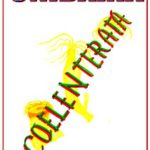

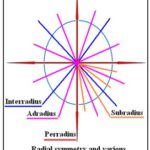
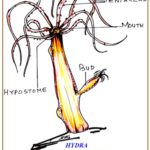
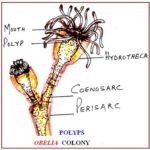
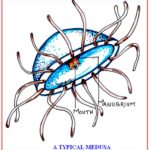
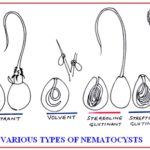
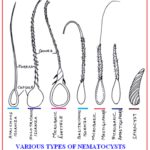
Learning process is an on-going process: Keep on venturing more into the fantastic world of Etymology and feel Cnidaria (= Coelenterata) – friendly!!! |



